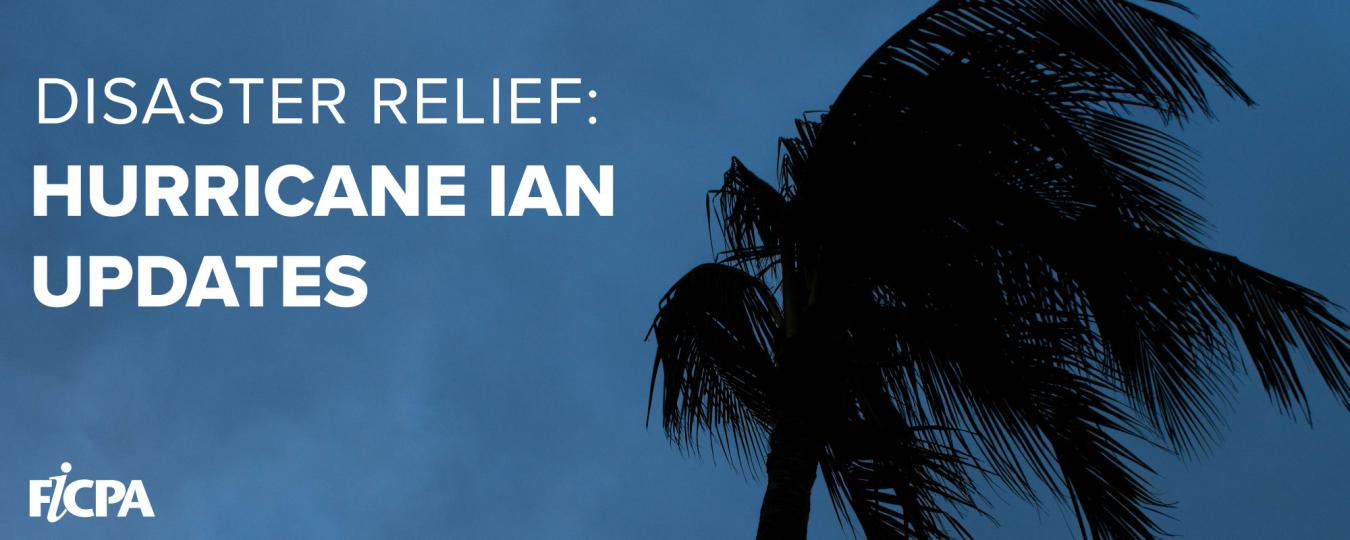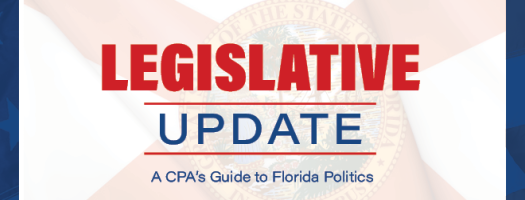
The most important items facing those affected by Hurricane Ian is how their practices will be affected including IRS and State filing relief and practice management issues. The chart below provides a county by county list of due dates for both Hurricanes Ian and Nicole. Not every county is granted a delay to March 15, 2023 for Hurricane Nicole. Practitioners will have to be observant of these.
| County | Hurricane Ian (9/23/22 - 2/15/23) |
Hurricane Nicole 11/7/22 - 3/15/23) |
| Alachua | X | X |
| Baker | X | X |
| Bay | X | |
| Bradford | X | X |
| Brevard | X | X |
| Broward | X | X |
| Calhoun | X | X |
| Charlotte | X | X |
| Citrus | X | X |
| Clay | X | X |
| Collier | X | X |
| Columbia | X | X |
| DeSoto | X | X |
| Dixie | X | X |
| Duval | X | X |
| Escambia | X | |
| Flagler | X | X |
| Franklin | X | X |
| Gadsden | X | X |
| Gilchrist | X | X |
| Glades | X | X |
| Gulf | X | X |
| Hamilton | X | X |
| Hardee | X | X |
| Hendry | X | X |
| Hernando | X | X |
| Highlands | X | X |
| Hillsborough | X | X |
| Holmes | X | X |
| Indian River | X | X |
| Jackson | X | X |
| Jefferson | X | X |
| Lafayette | X | X |
| Lake | X | X |
| Lee | X | X |
| Leon | X | X |
| Levy | X | X |
| Liberty | X | X |
| Madison | X | X |
| Manatee | X | X |
| Marion | X | X |
| Martin | X | X |
| Miami-Dade | X | X |
| Monroe | X | |
| Nassau | X | X |
| Okaloosa | X | |
| Okeechobee | X | X |
| Orange | X | X |
| Osceola | X | X |
| Palm Beach | X | X |
| Pasco | X | X |
| Pinellas | X | X |
| Polk | X | X |
| Putnam | X | X |
| Santa Rosa | X | |
| Sarasota | X | X |
| Seminole | X |
X |
| St. Johns | X | X |
| St. Lucie | X | X |
| Sumter | X | X |
| Suwannee | X | X |
| Taylor | X | X |
| Union | X | X |
IRS Filing Deadlines
The authority for the Internal Revenue Service (IRS) to grant disaster filing relief is found in 26 U.S.C. § 7508A – Authority to postpone certain deadlines by reason of Presidentially declared disaster or terroristic or military actions. Also, 26 U.S.C. § 165(i)(5)(A)- Losses, defines a federally declared disaster as “any disaster subsequently determined by the President of the United States to warrant assistance by the Federal Government under the Robert T. Stafford Disaster Relief and Emergency Assistance Act.” After the President authorizes disaster assistance, the Federal Emergency Management Agency (FEMA) identifies counties as qualifying for Individual or Public Assistance. Individual Assistance allows individuals and businesses to request financial assistance from FEMA. Public Assistance allows for a partial reimbursement from FEMA to a government entity for expenses incurred because of a disaster but does not provide direct assistance to the general public.
Previous disaster occurring near filing deadlines caused much anxiety amongst tax practitioners and finally Congress addressed it in 2019 in HR 1865-the Further Consolidated Appropriations Act providing an automatic 60 delay when there is major disaster declaration.
H.R.1865 – Further Consolidated Appropriations Act signed into law by the President on December 20, 2019 added Code Section 7508A(d) to provide for a “mandatory 60 day extension”. The language of this addition to Code Section 7508A is as follows:
‘‘(d) MANDATORY 60-DAY EXTENSION.—
‘‘(1) IN GENERAL.—In the case of any qualified taxpayer, the period—
‘‘(A) beginning on the earliest incident date specified in the declaration to which the disaster area referred to in paragraph (2) relates, and
‘‘(B) ending on the date which is 60 days after the latest incident date so specified, shall be disregarded in the same manner as a period specified under subsection (a).
‘‘(2) QUALIFIED TAXPAYER.—For purposes of this subsection, the term ‘qualified taxpayer’ means—
‘‘(A) any individual whose principal residence (for purposes of section 1033(h)(4)) is located in a disaster area,
‘‘(B) any taxpayer if the taxpayer’s principal place of business (other than the business of performing services as an employee) is located in a disaster area,
‘‘(C) any individual who is a relief worker affiliated with a recognized government or philanthropic organization and who is assisting in a disaster area,
‘‘(D) any taxpayer whose records necessary to meet a deadline for an act described in section 7508(a)(1) are maintained in a disaster area,
‘‘(E) any individual visiting a disaster area who was killed or injured as a result of the disaster, and
‘‘(F) solely with respect to a joint return, any spouse of an individual described in any preceding subparagraph of this paragraph.
‘‘(3) DISASTER AREA.—For purposes of this subsection, the term ‘disaster area’ has the meaning given such term under subparagraph (B) of section 165(i)(5) with respect to a Federally declared disaster (as defined in subparagraph (A) of such section).
‘‘(4) APPLICATION TO RULES REGARDING PENSIONS.—In the case of any person described in subsection (b), a rule similar to the rule of paragraph (1) shall apply for purposes of subsection (b) with respect to—
‘‘(A) making contributions to a qualified retirement plan (within the meaning of section 4974(c)) under section 219(f)(3), 404(a)(6), 404(h)(1)(B), or 404(m)(2),
‘‘(B) making distributions under section 408(d)(4),
‘‘(C) recharacterizing contributions under section 408A(d)(6), and
‘‘(D) making a rollover under section 402(c), 403(a)(4), 403(b)(8), or 408(d)(3).
‘‘(5) COORDINATION WITH PERIODS SPECIFIED BY THE SECRETARY.—
Any period described in paragraph (1) with respect to any person (including by reason of the application of paragraph (4)) shall be in addition to (or concurrent with, as the case may be) any period specified under subsection (a) or (b) with respect to such person.’’
IRS issued SBSE Memorandum SBSE-25-1120-0093 to implement the 7508A(d) change.
In addition to the mandatory “60 day extension” in Code Section 7508A(d), IRS will generally issue a News Release indicating additional filing relief available listing the counties covered by the filing delay. It should be noted IRS notes the filing delay with an “O Freeze” described below on the taxpayer’s Individual Master File or Business Master File depending on the type of taxpayer. The applicable zip codes in the affected counties are used the identify the taxpayers covered.
The IRS generally extends systemic tax relief to “affected taxpayers” in a “covered disaster area” as described in the Internal Revenue Manual (IRM) 25.16.1, Disaster Assistance and Emergency Relief, Program Guidelines.
However, as IRM 25.16.1.5.2, Determining the Appropriate Level of IRS Disaster Tax Relief Under IRC 7508A, states:
- The IRS has considerable discretion and flexibility in providing disaster relief under IRC 7508A.
Therefore, when determining if systemic tax relief is appropriate, the IRS evaluates factors such as the following:
- Nature of the event/expected impact
- Number of states affected
- Time of year when the disaster occurred
- Imminent major filing dates
- Efficiency of FEMA’s declaration process
For taxpayers who experienced a disaster related hardship and did not receive systemic disaster assistance, IRM 25.16.1.5, Disaster Tax Relief Options, provides:
- The IRS, under Internal Revenue Code sections 6081 and 6161, may abate failure to file or failure to pay penalties for up to six months based on reasonable cause criteria. To receive the penalty abatement, a taxpayer must call the IRS at the toll-free number listed on their penalty notice and explain the situation to the assistor. If the taxpayer qualifies for the abatement, the assistor will manually adjust the tax account.
IRM 21.5.6.4.30 (10-01-2016)
-O Freeze
The -O (Disaster Indicator) freeze will only be input systemically by Information Technology Services (IT) at the request of the Disaster Program Office or on a case-by-case basis by Compliance personnel. Employees outside of Compliance will no longer input the -O freeze.
Reminder:
Taxpayers will no longer self-identify for disaster relief by writing a disaster designation in red at the top of their tax return.
The -O freeze allows for special penalty and interest calculations
The -O freeze suppresses some Master File and IDRS notices
The -O freeze does not freeze the module from refunding
The -O freeze may be systemically set on identified taxpayer accounts in presidentially declared disaster areas
The -O freeze is released when the current date is beyond the secondary date (disaster ending date) of the TC 971 AC 087
When performing account research the -O freeze is seen on CC ENMOD, CC IMFOLE or CC BMFOLE.
If a Practitioner calls, is located in a covered disaster area and maintains records for several taxpayers located outside the disaster area, inform the Practitioner to:
Call the Special Service line 1-866-562-5227
State Filing Relief
Many states will piggy back Federal filing relief. Practitioners will have to check with the respective State Revenue Departments to determine what is applicable in the particular jurisdiction.
Practice Management Issues
The filing delays for Hurricanes Ian and Nicole provide challenging practice management issues. These include having a multitude of filing deadlines back to back in 2023. There will be the January 31, 2023 deadline for information returns, February 15, 2023 and March 15, 2023 for Ida and Nicole related returns, March 15 and April 15, 2023 for 2022 returns.
Additional considerations are the inability to e file returns while the Individual e file system is off line to update for 2022 returns. No one wants the experience of having to paper file a return unless absolutely necessary.
Those who print tax organizers in November, December or early January will find that prior year figures will print as zero if the 2021 return has not been filed.
Conclusion
Florida CPAs affected by Hurricanes Ian and Nicole have a challenging road ahead of them. Many are working to assist them with IRS issues and other items affecting their lives and practices. Be patient, things will be sorted out and there is light at the end of the tunnel!

